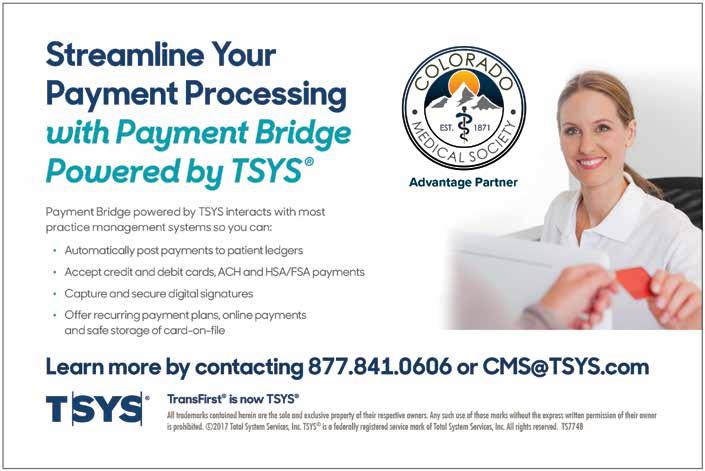
4 minute read
INNOVATION IN TELEMEDICINE WITH PHYSICIAN BUY-IN
Telemedicine: Why Colorado is a hub for innovation and physician buy-in CPMG PHYSICIAN DESCRIBES HOW TECHNOLOGY HAS ENHANCED TRADITIONAL OFFICE VISITS Kate Alfano, CMS Communications Coordinator
Increasing use of technology in all facets of society has brought new and novel ways for patients and physicians to interact digitally.
Advertisement
Kaiser Permanente and the physicians of Colorado Permanente Medical Group (CPMG) who care for the 620,000 members of Kaiser Permanente have deployed a host of telemedicine tools across their system to enhance access to care. These tools allow physicians and their care teams to enable members to book phone and video appointments with primary care physicians and behavioral health providers, expand remote patient monitoring and management, and enhance their Chat with a Doctor function to allow communication between patients and a local CPMG physician in real time.
Kaiser Permanente’s Chat with a Doctor, specifically, rolled out in November 2016 with the intention to help reduce unnecessary emergency department visits.
“When we first launched it, we intentionally kept it open-ended,” says Ari Melmed, MD, a CPMG emergency medicine physician. “The initial call-to-action on the website was ‘click to chat.’” Melmed explains many of the early connections were for basic medical advice but also about navigating Kaiser Permanente’s health care system.
The Chat with a Doctor service has increased in popularity and has expanded to include local financial counselors, pharmacists and additional member services experts. The function will soon allow patients to book appointments for clinic visits and even mammograms.
“Chat started as an experiment of sorts to see how members would use the service – we’ve adapted and continue to meet the unique needs of our members. We’re proud of all our physicians and other experts who took on this challenge and created something truly valuable to our members — from convenience to quality of care, this service is exceptional,” Melmed says.
According to Melmed, the most common medical questions patients ask on Chat with a Doctor are about upper respiratory symptoms, urinary tract infections, rashes, pediatric issues or lacerations, as well as more sensitive concerns about sexually transmitted illnesses or behavioral health concerns.
Users of the Chat feature tend to skew younger, though it appeals to all ages, and now that it’s been added to the Kaiser Permanente mobile app, patients are engaging doctors instantly from wherever they are when it’s convenient for them. The system currently manages 500-600 chats per day with expected growth to more than 1,000 in the near future.
The overarching question for all of the unique medical concerns is: “Do I need to come in?” Melmed estimates 25-30 percent of the chats require an in-person evaluation for a physical exam, laboratory services or radiographic studies, but that most of the questions can be resolved through Chat.
“Patients are more informed – often entering their symptoms in an online search before engaging a physician, but when it comes to informing their decision more specifically, they need that professional contact to contextualize their question and help them understand whether they need to be seen in person, how soon they need to be seen and by whom,” he says. “We can ask a few questions and often we can give specific advice. That’s the contact the member needs.”
nente’s integrated system with an integrated electronic medical record that allows for use of telehealth tools in a robust manner, Melmed says.
Melmed admits that, as a physician, he was skeptical when he first heard the pitch for Chat with a Doctor. He didn’t think there could be enough information transmitted back and forth to make reliable professional decisions.
“I was shown otherwise,” he says. “Some of the doctors enter with a certain degree of skepticism but the vast majority of them really enjoy the work. It’s a fun way to interact with patients. The patients are so grateful for the opportunity to be treated in such a convenient and personalized way — knowing we’re caring for our members this way, it’s great to be a part of as a physician.”
This kind of digital interaction allows physicians flexibility in their schedule, too. They may have 4.5 days a week of clinic and a few additional hours from home working Chat with a Doctor.
“Increasingly our doctors are more interested in managing their weekly schedule to be just a little bit less regimented than they have been in the past with five straight days a week of full days,” he says. Melmed feels that telehealth services including Chat give physicians the chance to innovate and experiment with what it means to deliver medical care.
“I think a lot of the docs have enjoyed the energy of discovery. We communicate with each other to try and maintain best practices, that antibiotics are used appropriately and that we’re giving consistent advice between providers. We’ve found that there has been a robust exchange of ideas among physicians who are discovering ways of asking questions and ways of answering concerns. It has been engaging for the team. We’re in medicine to help our patients feel better and sometimes that means just talking to patients to help put them at ease — Chat is one more way we can help our patients and it’s gratifying.”
Reflecting on the overall progress of advancing technology,
Melmed says: “I think we’re pushing the traditional boundary a
little bit with regard to what we can do and how much we can
manage virtually. Given the infrastructure that our system has,
we’re able to set in motion plans of care that in the past would
have required an in-person evaluation. As we proceed and
monitor the quality and the safety of our program, we’ll establish
a new set of boundaries and limitations for what can be done
in telehealth.” ■









